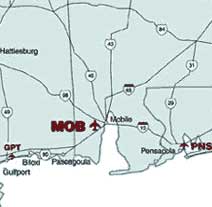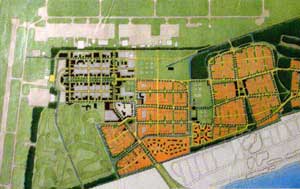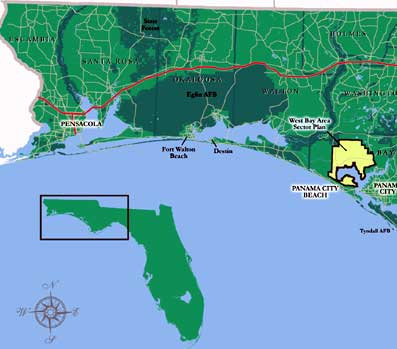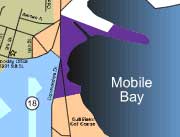ne company’s scandal is another company’s opportunity.
Last year, the U.S. Air Force had a preliminary US$23-billion
dollar deal with Boeing to lease and buy 100 aerial refueling tankers.
But the deal fell apart amid a growing procurement scandal. Last May,
Defense Secretary Donald Rumsfeld returned the process to square one by
ordering outside studies to determine the Air Force’s tanker needs. And
just recently, the Air Force asked for additional analysis, delaying further
efforts to replace the nation’s aging tanker fleet. While the situation
has proved difficult for Boeing, it has created tremendous opportunity
for EADS, the European aviation and defense company that is the parent
of Boeing competitor Airbus.
On January 12, 2005, EADS declared its intentions to compete for the Air Force’s business by issuing an RFI to all 50 states as the first step in a process to site a U.S. manufacturing and engineering center for its Airbus tankers and commercial jets. In issuing the RFI, EADS launched a one-year search for a site to house a Military Modification and Assembly Line, which the company estimated would cost $600 million
and could eventually employ up to 1,100 workers. According to EADS, only 150 of the jobs are guaranteed; the rest are dependent on the company receiving a substantial tanker order from the U.S. Air Force.
Each state could propose up to three sites for consideration.
States had to identify their proposed sites by March 1, and each site
must submit its RFI response by March 30.
Playing the Game
In moving to take advantage of the opportunity presented
by the Boeing scandal — and in its management of the site selection
process to date — EADS has proven itself to be one smart company.
EADS knows that to sell tankers to the Pentagon,
it needs a U.S. assembly facility to meet “Buy America” laws. The company
launched a nationwide search, contacting all 50 states, as part of its
process to site a facility. The result has been public relations boon,
as states position themselves for the competition.
EADS even tapped the quarterback of America’s Team,
Roger Staubach, to lead the site selection search. For Americans of a
certain age, Staubach was the consummate quarterback, leading the U.S.
Naval Academy to glory before
 |
Part of the site-selection team convenes: EADS
North America Chairman and CEO Ralph Crosby (at right) speaks with
Staubach Company Chairman and CEO Roger Staubach (center) and Staubach
Senior Vice President John Totushek (left) after the press conference
kicking off the project. |
winning two Super Bowls with the Dallas Cowboys. Since leaving football,
Staubach has built one of the nation’s leading real estate advisory firms.
Earlier this month, EADS hosted an information day
in Washington, D.C., for states interested in proposing potential sites.
Thirty-five states attended the meeting, including nine states with
ties to Boeing. By all accounts, EADS was very pleased with the level
of participation and interest.
By engaging state economic development agencies
in the RFI process, EADS is activating an important constituency that
could eventually help the company lobby Congress to ensure an open,
transparent competitive bidding process.
As a European company, EADS faces a clear challenge
in winning an Air Force contract to supply the vitally important tankers.
A number of military observers have suggested the Air Force and the
Pentagon would be reluctant to buy from an overseas manufacturer. EADS
may have to partner with a U.S. defense firm like Northrop Grumman or
Lockheed Martin to “Americanize” its bid.
On the other hand, attitudes in Washington may be
changing. Brazilian jet maker Embraer teamed up with Lockheed Martin
for the Army’s aerial common sensor program, and will build the jets
at a new facility in Jacksonville, Fla. And just last month, the Navy
announced that Italian helicopter maker AgustaWestland will make the
next presidential helicopter at a plant in Owego, N.Y. The win was a
significant upset over Connecticut-based Sikorsky. Finally, corporate
leaders involved with the Alenia-Vought project that just chose South
Carolina have expressed interest in bidding on DOD work.
The RFI process, as devised by EADS and managed
by Staubach, provides the perfect forum for educating opinion leaders
in the United States about the company — and showing its commitment
to the U.S. market.
Site Selection Criteria
Even though all 50 states were invited to submit proposals for up to three sites each, EADS has a very specific set of site selection criteria that will limit the bidding. To be truly competitive, a location needs space for a 9,000-ft. (2,743-m.) runway, 1.5 million sq. ft. (139,350 sq. m.) of production, hangar and office space with easy access to the runway, access to a deepwater seaport, and an affordable way to transport oversize airplane components from the seaport to the airport.
Of all the criteria, the airport-seaport combination is the most problematic. EADS plans to ship large plane components from Europe to a roll-on roll-off deepwater seaport. The components then need to be transported via barge, road or rail to the airport. Sounds simple, but in fact it is very difficult because of the size of the components.
EADS requires clearances that can accommodate components
that are 23 ft. (7 m.) in height and width and 111 ft. (33.8 m.) long. That’s
like moving a two-story building that’s more than two tractor-trailers long.
Generally speaking, the route must be clear of power lines, street lights,
bridge or rail overpasses — and must be able to provide a width of
at least two typical traffic lanes.
|
|
 |
|
Mobile, Alabama: Mobile Brookley World War II Air
Force.
|
This process is so cumbersome that in France, where it was invented and perfected, it has a name all its own: The Grand Itinerare. Needless to say, many airport-seaport combinations, particularly in the more congested East Coast port, can’t provide an unobstructed route between the airport and the seaport.
There are other limiting factors:
- West Coast airport-seaport combinations are out because of the increased
shipping time from Europe. Gulf Coast airport-seaport combinations would
work, but one would think East Coast sites probably have slight advantage.
- However, most East Coast airport-seaport combinations are too urbanized
to move the oversized plan components; most simply do not have the room
and land-use compatibility to accommodate EADS.
- Nationwide, not many airports proximate to a deepwater port have
a 9,000-ft. primary runway that is 150 ft. (45.7 m.) wide and can support
a 73,000-pound rolling load. Typically, runway extensions take a long
time to get approved (if they ever are) and are very expensive.
And there is the intangible criterion: Political muscle. EADS is looking for a strong political partner help make the company’s case in Washington. And as anyone who’s observed a presidential election knows, some states are more politically important than others.
Three to Watch
Who might make a list of leading contenders to EADS? Based on the established site criteria and other logical factors, there appear to be three Gulf Coast contenders worth watching: Mobile, Ala.; New Orleans, La.; and Panama City, Fla.
Mobile, Alabama: Alabama has proven time and again it
knows how to compete to attract new businesses. Since winning a Mercedes
Benz plant fifteen years ago, the state has racked up some impressive wins.
 |
New Orleans, Louisiana: The former Belle Chase Navy
Base. |
Alabama has a strong contender in its Mobile Brookley
site. The World War II Air Force base has a 9,600-ft. (2,926-m.) runway
and good access to the Port of Mobile. It also has a workable industrial
area proximate to the runway. Mobile is hungry and organized, and will likely
be a strong contender in this process.
A couple of weaknesses may give EADS pause, though. The site is a World War II military base, and like many others around the country and the world, it could have serious site remediation issues. It’s like renovating an old house. You never really know what you are going to find until you start to take it apart. And like many sites in a coastal zone, Brookley is exposed to hurricane risks each fall.
New Orleans, Louisiana: The former Belle Chase Navy
Base in New Orleans looks like a potentially strong contender too. The site
has a 10,000-ft. (3,048-m.) runway and immediate access to the Port of New
Orleans. EADS is familiar with Louisiana because it employs 300 people at
an aviation maintenance facility in Chenault, near Lake Charles.
But New Orleans has two weaknesses worth noting. Its site is even more vulnerable than Mobile’s Brookley to potential hurricane damage. If a hurricane ever did hit, most of New Orleans would be underwater. With hurricane activity forecast to increase over the next twenty years, it could be a consideration. And second, because EADS already has a presence in the state, there could be little political benefit to adding another facility.
Panama City, Florida: Panama City is a definite wild
card in this competition. The community is in the process of
 |
| Panama City, Florida: West Bay Area. |
relocating its airport to a greenfield site in northwestern Bay County,
outside the hurricane surge zone. The local Airport Authority’s current
schedule anticipates groundbreaking on the new airport in 2006. Port Panama
City is a short barge trip away, and the community could set up its own
version of the “Grand Itineraire” to transport the oversize plane components.
The new airport is the centerpiece of a 74,000-acre
(29,948-hectare) long-term land-use plan that would offer EADS the opportunity
to build to spec from the ground up, and would offer unlimited future expandability.
In fact, it may be the most expandable, flexible aviation-oriented site
in the country.
The site’s weakness is obvious: There’s no airport yet — and the approval process is not yet complete. The FAA is expected to issue its final Record of Decision on airport relocation by the end of the year, and other legal and regulatory issues could delay construction. Right now, the airport relocation schedule and the EADS draft production schedule line up pretty well. However, both processes could be subject to delay. If
airport relocation falls behind the contracting process, it could disqualify the site. (For background on these developments read the Florida Spotlight published in the Sept. 2003 issue of Site Selection.)
A Battle to the End
No doubt there are other sites worthy of EADS’ close
consideration. The company has played it smart so far, and there is every
reason to believe they will continue to do so. It’s unlikely they will
leave any stone unturned.
One intriguing possibility: Since Panama City is a
greenfield site, EADS may find value in keeping them in the competition,
if for nothing more than a point of comparison. Panama City is the closest
thing to a blank slate the company will find in this process, and for
that reason alone, it’s valuable to have them remain in the competition.

Based on a preliminary review, Mobile appears to be
emerging as the site to beat. The Alabama team is fully on board, and
you can be sure they will pursue this project very aggressively. They
have the experience to navigate the site selection process — and
the Brookley site appears to be able to meet most of the site criteria.
But this will be a battle to the end, and there will
be twists and turns aplenty. In addition to tracking the site selection
competition, though, observers have to keep watching the Air Force, the
Pentagon and Congress. Before it’s all over, they will all weigh in on
the process to build this nation’s next generation aerial refueling tanker.

Editor’s Note: For further insights into the EADS site selection process, read Jack Lyne’s February coverage of the search launch.
For more background on many of
the topics discussed in this article, read Site Selection’s exclusive
coverage of the Vought-Alenia site selection in South Carolina from our
March 2005 issue. Compare and contrast the unfolding EADS process with
the Boeing 787 plant site selection process, from our March 2004 issue.
Find out more about Embraer’s m.o. in the Aerospace Industry Review from
our Nov. 2004 issue. And be sure to check out Jack Lyne’s recent piece
on the upset of Sikorsky by AgustaWestland.






